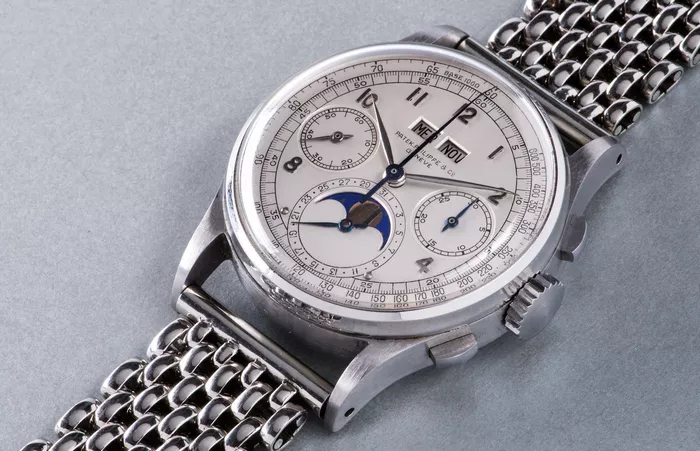Patek Philippe, a name synonymous with luxury and precision, reached the pinnacle of watchmaking excellence with the introduction of the Patek Philippe 1518 in 1941. This horological masterpiece stands not only as a testament to the brand’s commitment to craftsmanship but also as a landmark in the history of wristwatches. The 1518 is not just a timepiece; it’s a fusion of artistry and engineering that continues to captivate watch enthusiasts worldwide. In this comprehensive guide, we will embark on a journey to explore the historical roots, design intricacies, and enduring legacy of the Patek Philippe 1518.
I. A Glimpse into History: The Birth of Patek Philippe 1518
The Patek Philippe 1518 made its debut during a time of global upheaval – the early 1940s. Against the backdrop of World War II, Patek Philippe introduced a watch that would redefine horological standards. In 1941, the world witnessed the birth of the 1518, the first-ever perpetual calendar chronograph wristwatch. This section will delve into the socio-economic and horological landscape of the era, providing context for the innovation and craftsmanship that culminated in the creation of the Patek Philippe 1518.
II. Design Excellence: Unraveling the Aesthetics of Patek Philippe 1518
The design of the Patek Philippe 1518 is a symphony of elegance, functionality, and attention to detail. Its 35mm case, a harmonious blend of curves and straight lines, houses a dial that reflects a timeless aesthetic. Roman numerals, delicate hands, and sub-dials indicating day, month, and a 30-minute counter for the chronograph contribute to the watch’s visual appeal. This section will unravel the design elements, examining how each component adds to the overall aesthetics of the Patek Philippe 1518. The choice of materials and the craftsmanship invested in the case and dial speak to Patek Philippe’s unwavering commitment to excellence.
III. Craftsmanship at its Finest: The Movement of Patek Philippe 1518
The heartbeat of the Patek Philippe 1518 lies within its mechanical movement – a marvel of precision and artistry. The caliber inside the 1518 is a testament to Patek Philippe’s watchmaking prowess, featuring intricate details, hand-finishing, and meticulous assembly. This section will delve into the complexities of the movement, exploring the intricacies of the perpetual calendar and the precision of the chronograph mechanism. The movement isn’t merely a functional component; it’s a work of art that elevates the Patek Philippe 1518 into the realm of horological masterpieces.
IV. Rarity and Collectibility: Patek Philippe 1518 in the Market
The Patek Philippe 1518, produced in limited numbers, has become a rarity in the world of watch collecting. With only 281 pieces crafted during its production run from 1941 to the early 1950s, the 1518 is a highly sought-after collector’s item. This section will explore the factors contributing to its rarity, such as variations within the series and the finite number of watches available in the market. Additionally, we will discuss how auction results have played a significant role in shaping the collectibility and market value of the Patek Philippe 1518.
V. Legacy and Influence: Patek Philippe 1518’s Impact on Watchmaking
The Patek Philippe 1518 transcends its role as a timekeeping device; it is a milestone in the evolution of watchmaking. Its groundbreaking combination of a perpetual calendar and chronograph set a precedent for future timepieces. This section will delve into the enduring legacy of the Patek Philippe 1518, exploring its influence on subsequent watch designs, complications, and the perception of what a wristwatch could achieve. Understanding its lasting impact enhances the appreciation for the 1518 as a trailblazer in the horological world.
VI. Frequently Asked Questions
1. How many Patek Philippe 1518 watches were produced?
The Patek Philippe 1518, introduced in 1941, had a limited production run, with only 281 pieces crafted. This exclusivity contributes to its status as a highly sought-after and rare timepiece among collectors.
2. What makes the Patek Philippe 1518 a perpetual calendar chronograph?
The Patek Philippe 1518 is celebrated as the world’s first perpetual calendar chronograph wristwatch. It seamlessly combines the functionality of a chronograph, allowing precise time measurements, with a perpetual calendar that automatically adjusts for varying month lengths and leap years.
3. What are the key design elements that define the Patek Philippe 1518?
The Patek Philippe 1518 is characterized by a 35mm case, Roman numerals on the dial, delicate hands, and sub-dials indicating day, month, and a 30-minute counter for the chronograph. These design elements contribute to its timeless and sophisticated aesthetic.
4. How has the rarity of the Patek Philippe 1518 impacted its market value?
The rarity of the Patek Philippe 1518, stemming from its limited production and historical significance, has significantly impacted its market value. Collectors place a premium on obtaining this horological treasure, and auction results often reflect its elevated status in the market.
5. What is the lasting legacy of the Patek Philippe 1518 in the watchmaking industry?
The Patek Philippe 1518 is celebrated not only for its technical innovation but also for its enduring legacy in the watchmaking industry. Its groundbreaking combination of complications has influenced subsequent designs, setting a standard for perpetual calendar chronographs and solidifying its place in horological history.

